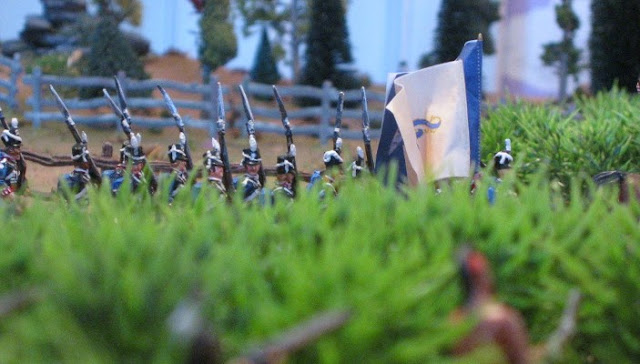Renovations are still holding my games room (and me) hostage but last weekend, I did manage a quick game at a friend's place. A CS Grant scenario played with 15mm troops using Blitzkrieg Commander adapted for use with Hexon hexes deployed on a dining room table. I lost, (1939 Poles not quite blowing a bridge) but it was an enjoyable couple of hours. The puzzling thing is, despite this being, on the surface "the usual", as I drove home, I realized that it had felt like a "game" as opposed to a "wargame". Why? What did that mean?
Well after much thought and various lengthy but aborted blog entries, I think I have some idea. Most historical miniature wargamers are probably familiar with the description of the hobby as a blend of gaming, modelling and history. Expanding the gaming section, I have come up with another set of overlapping interests:
a) recreation of history (or of the chosen background if doing non-historical gaming).
b) imagination including role playing and story creation and story telling, essentially pretending that you are "there" on the table, taking part.
c) competition or playing a game according to fixed rules.
Now when I was fiddling with the following digram, I hadn't put it quite that way so the 3 sectors are labelled History, Imagination and Game.
The Green area in the middle is my particular sweet spot, a prefect mix of a regulated, competitive game, recreation of history and a chance to exercise my imagination as I pretend to be there amongst my toy soldiers, leading them to Victory.
The areas with no overlap are the Prime ingredients that go into the gaming aspect of wargaming. An example of the pure Imagination area would be a boy (of any age) playing with toy soldiers, no rules, no attempt to recreate history per se, just imagining himself as the hero of some adventure. Risk might be considered an example of the Game portion, while a re-fight of an historical battle by historians as a learning exercise might be considered to fall into the recreating History portion.
The areas where 2 circles overlap are getting closer to my sweet spot. The original Little Wars would be an example of a mix of Imagination and Game with no taint of history while a role playing game using miniatures and an historical setting might be set where Imagination and History cross. After much thought, the Yellow zone is where I found myself last weekend. The game was challenging and fun and reflected history and indeed whenever we found ourselves in an ambiguous situation, we were as likely to make a decision based on what was likely possible historically as what was legal under the rules. But, I never really imagined myself as "being there".
Why not? I don't believe that it was any one thing, it was the convergences of several factors, some definitely personal and some perhaps more general. The personal ones included such things as being somewhat distracted by a call from home (a non-problem as it later turned out) and the fact that I was not using miniatures that I had painted (its silly but my imagination and sense of engagement increases when using my own lads)and was playing a period (Poland 1939) that I have only a superficial knowledge of. A possibly more general one is that the game was fairly abstract with a small number of small figures on a hex grid. Now, I am not a "moving diorama" guy, more of a toy soldier sort, but a single 15mm figure standing in for a squad felt like a playing piece and while the hexes were darned convenient for measuring and movement, they also detracted a little from the illusion. Its harder to imagine yourself on the radio. ordering "Red Two This is Red One move 2 hexes to your left". On another day my imagination might have been strong enough to overcome the abstractions but at least it was a fun day as it was.
The point? Well, unfortunately, there isn't one really! Its just another view to think about.
I'll leave this with an excerpt from HG Wells' Littlewars, just to show its not just me:
"And suddenly your author changes. He changes into what perhaps he might have been—under different circumstances. His inky fingers become large, manly hands, his drooping scholastic back stiffens, his elbows go out, his etiolated complexion corrugates and darkens, his moustaches increase and grow and spread, and curl up horribly; a large, red scar, a sabre cut, grows lurid over one eye. He expands—all over he expands. He clears his throat startlingly, lugs at the still growing ends of his moustache, and says, with just a faint and fading doubt in his voice as to whether he can do it, "Yas, Sir!" "
Lurking in ambush,waiting anxiously for the signal to attack as the enemy marches slowly past.





















